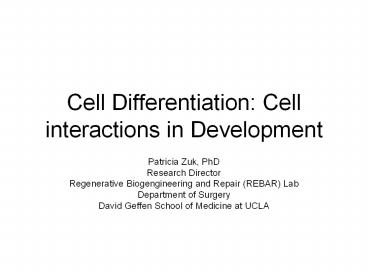Cell Differentiation: Cell interactions in Development - PowerPoint PPT Presentation
Title:
Cell Differentiation: Cell interactions in Development
Description:
Cell Differentiation: Cell interactions in Development Patricia Zuk, PhD Research Director Regenerative Biogengineering and Repair (REBAR) Lab Department of Surgery – PowerPoint PPT presentation
Number of Views:70
Avg rating:3.0/5.0
Title: Cell Differentiation: Cell interactions in Development
1
Cell Differentiation Cell interactions in
Development
- Patricia Zuk, PhD
- Research Director
- Regenerative Biogengineering and Repair (REBAR)
Lab - Department of Surgery
- David Geffen School of Medicine at UCLA
2
- so cells can interact with each other and with
their environment - this interaction turns specific signaling paths
ON or OFF - these pathways become important for mediating
proliferation, differentiation and apoptosis - all three are crucial to development
3
Differentiation Stem cells
- so fertilization of the egg takes place in the
oviduct - the fertilizes zygote travels to the uterus for
implantation - along the way the zygote begins to divide
(mitosis) - 2-cell, 4-cell, 8-cell embryonic stages etc.
- the embryo reaches a stage called the morula
ball of small cells (embryo has not enlargened) - by the end of the first week the second embryonic
stage the blastocyst - forms
4
Differentiation Embryonic Stem cells
- the blastocyst is a hollow ball of cells
containing an outer rings of progenitor cells
trophoblast and an inner mass of cells at one end
of the embryo inner cell mass - it is these ICM cells that are the source for the
derivation of embryonic stem (ES) cells
- the ES cells are said to be totipotent have the
ability to specialize or differentiate into ALL
cells of the embryo - the blastocyst then begins a process of
differentiation and these ES cells form
populations of stem cells with more restricted
potentials - the ES cells first differentiate into two layers
called the embryonic disc divides the
blastocyst cavity into an amniotic cavity and a
yolk sac (primitive hematopoietic organ) - these two layers then continue to differentiate
into the three germ layers of the embyro - ectoderm, mesoderm and endoderm
- the formation of these germ layers marks the
gastrula embryonic stage
5
Germ Layers
- the ectoderm, mesoderm and endoderm are thought
to be made up of stem cells with a more
restricted phenotype when compared to ES cells
BUT still capable of forming multiple cell types
within that lineage - e.g. pluripotent stem cells
- interactions between signaling molecules produced
by these germ layers and with the developing ECM
around these tissues results in specific
developmental events patterning - patterning requires the exposure of cells to a
succession of signals and subsequent activation
of their associated pathways
6
Cellular interactions in development Induction
- interactions between the cells of the germ layers
influence the fate of the stem cells within these
layers - can affect their differentiation paths
- induction mechanism where one cell population
influences the development of neighbouring cells - e.g. mesoderm induces the overlying ectoderm to
form neural tissue - embryonic development is a series of inductive
events - binary have a choice between one fate or
another (presence of one signal development
down one path, absence of signal development
down another path - gradient multiple fates may result dependent
upon the level or threshold of the signaling
molecule (these signaling molecules are called
morphogens) - relay a signal induces a cascade which
determines the fate of cells in proximity these
cells than produce additional signals which
affect the fate of their neighbours
7
Cellular Interactions Patterning and TGFb
superfamily signaling
- a number of extracellular signaling molecules
play roles in determining the fates of developing
cells and where these cells will develop - TGFb superfamily TGFb, BMPs, activin (BMP2 and
BMP4) - wide role in development
- mediate proliferation of stem cells
- can determine stem cell fate e.g. BMP4
mesoderm - also mediate the production of CAMs, growth
factors, ECM molecules all which play roles in
cell signaling and resulting differentiation
responses - homologs found in multiple vertebrates
- binding of these homologs to their receptors
results in their activation - this activation phosphorylates/activates
downstream adaptors called Smads - a cascade of Smads are activated resulting in
eventual nuclear translocation and regulation of
gene expression - these Smads are specific to the TGFb superfamily
growth factor (Smad 1 BMP2, Smad 2 TGFb) - this signaling path is fine-tuned by the action
of several adaptor proteins (chordin, xolloid,
noggin) - this fine tuning can result in the induction of
neural tissue as opposed to mesodermal tissue and
results in the patterning of tissues within the
embryo
8
Other Patterning Signal Paths
- numerous other patterning pathways comprised of
multiple signaling proteins - e.g. hedgehog pathway patterning of local
tissues and determination of cell fates - initial studies in Drosophila
- homologs now characterized in vertebrates
- hedgehog (sonic and indian hh in vertebrates),
wingless (Wnt in vertebrates), patched,
smoothened, dishevelled - limb patterning FGF, sonic hedghog,
- neural tube differentiation sonic hedgehog
gradients
9
Want to know how ridiculous this gets??
- other signaling molecules in cell
differentiation/tissue fate determination - brachyury mesoderm
- goosecoid
- toll, spaetzle, cactus dorsal
- dorsal targets snail, twist, rhomboid
- delta, notch, jagged, suppressor of hairless
- hunchback, Kruppel
- even-skipped, fushi-tarazu































